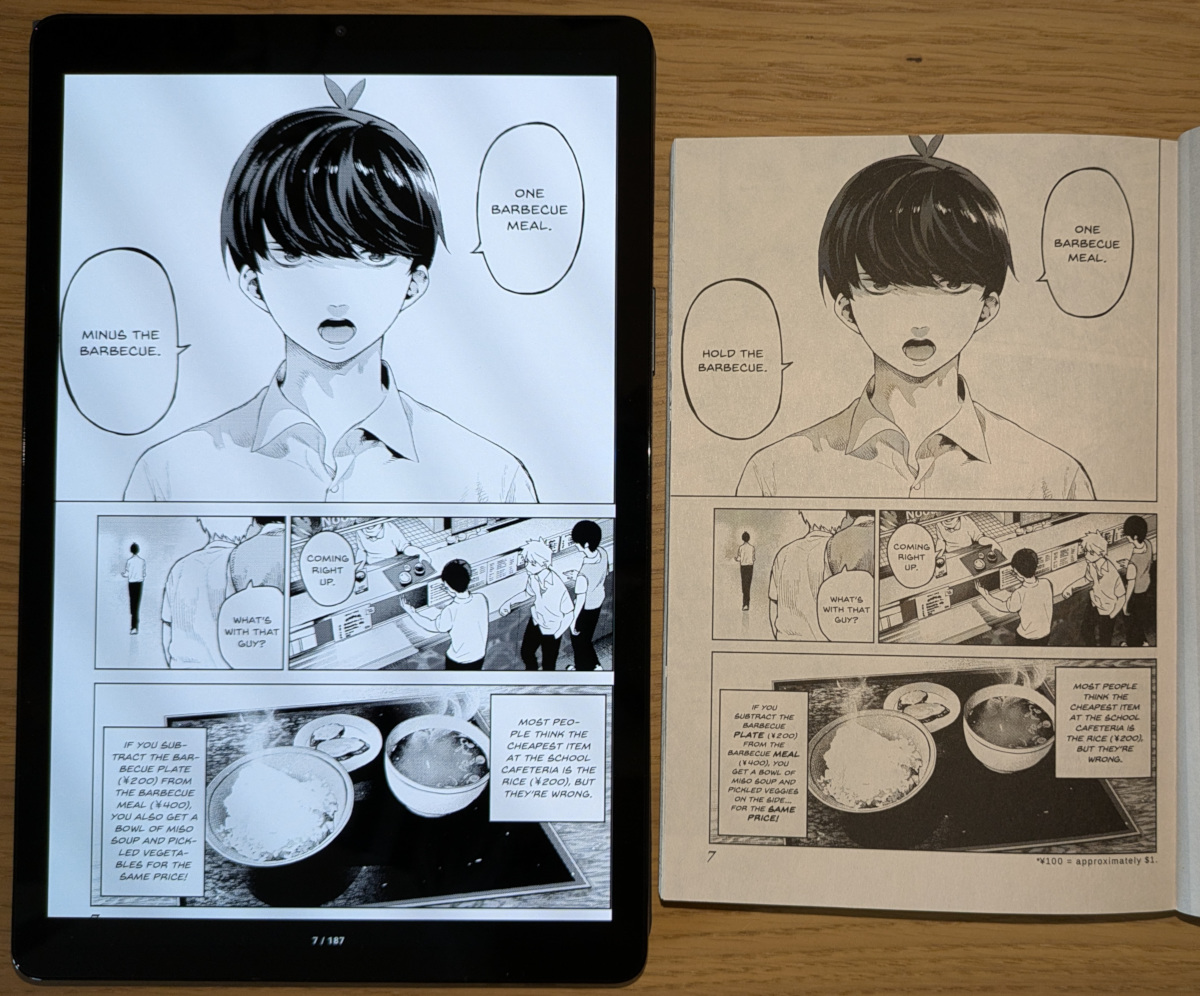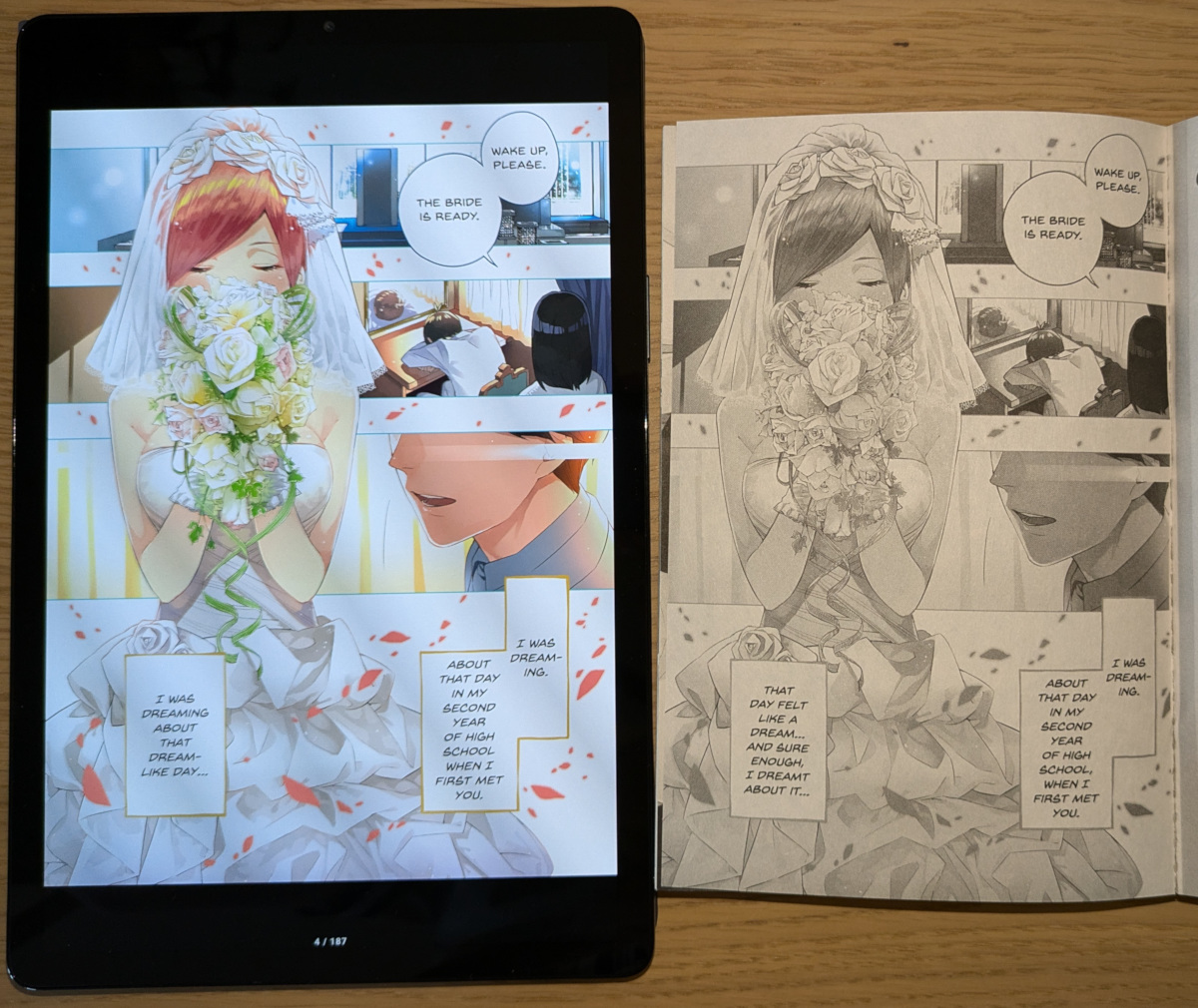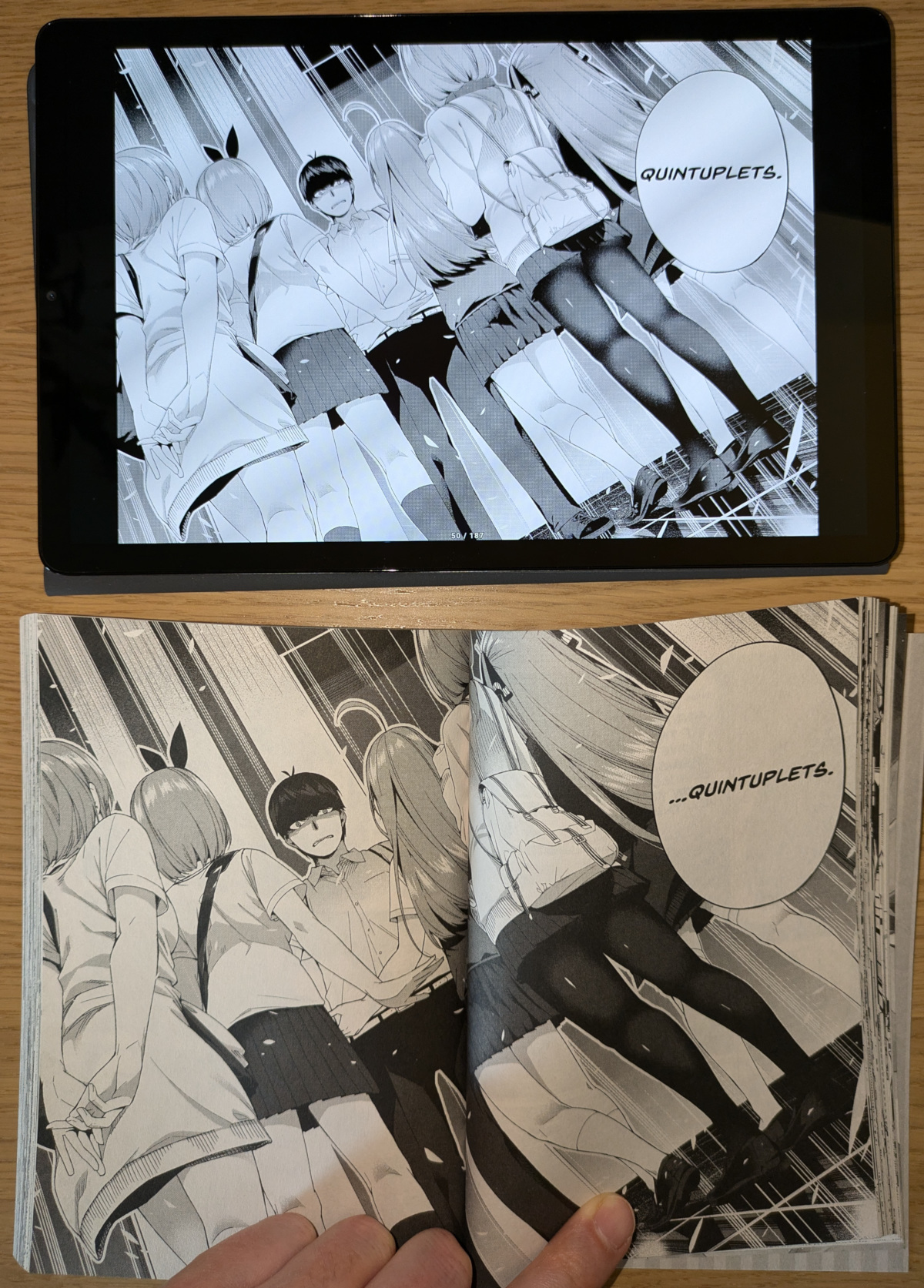There’s pretty much two ways to read manga: you can buy physical volumes, or you can buy digital editions to read on a phone, tablet, or laptop/PC. Whether you go physical or digital is a personal preference. I’m mostly indifferent when it comes to books, but for manga I prefer to read digitally, and in my opinion there is (still) no better way to do so today than on the Samsung Galaxy Tab S5e, released in 2019. Let me explain.
The unicorn tablet
I’ve been using the S5e for 3 years at this point. In retrospect, this device is a bit of a unicorn. It offers a combination of specs that make it perfect for manga reading, but which are almost impossible to find together in a single tablet today. Namely:
- An amazing screen:
- At 10,5” it strikes a good balance between something that’s large enough to properly bring out a manga’s art without becoming too bulky or uncomfortable to hold.
- Its 16:10 aspect ratio is a decent fit for most manga.
- Its 288ppi pixel density is very close to what you get on a good paper print.
- It uses OLED screen technology, which not only means great colors but it also means blacks will be truly black. Most manga are black and white, of course.
- A microSD slot to put your manga library on.
- A somewhat reasonable weight of 400g.
- A full Android OS.
- Reasonably priced at € ~350.
This list initially might not seem all that special, but it turns out it’s actually surprisingly difficult to find a tablet (or e-reader) on the market today that can compare. So, let’s do some totally-non-exhaustive market research.
For the record, I own the cheapest S5e model (the 64GB wifi variant), which I was able to snag on sale for less than € 250 in 2021. Let’s see what we can find today.
If we want an OLED screen, the options are pretty much limited to the following:
| Galaxy Tab S9 | Galaxy Tab S9+ | Apple iPad Pro (2024) | |
|---|---|---|---|
| Screen size | 11” | 12,4” | 11” |
| Aspect ratio | 16:10 | 16:10 | 3:2 |
| Pixel density | 274ppi | 266ppi | 267ppi |
| Expandable storage | microSD | microSD | - |
| Weight | 498g | 581g | 444g |
| Price (july 2024) | € 553 | € 819 | € 1.129 |
If we go for an LCD screen, we have a bit more choice, and some possible options look like this:
| Galaxy Tab A8 | Galaxy Tab A9+ | Apple iPad (2022) | Xiaomi Pad 6 | |
|---|---|---|---|---|
| Screen size | 10,5” | 11” | 10,9” | 11” |
| Aspect ratio | 16:10 | 16:10 | 59:41 🤔 | 16:10 |
| Pixel density | 216ppi | 206ppi | 264ppi | 309ppi |
| Expandable storage | microSD | microSD | - | - |
| Weight | 508g | 491g | 477g | 490g |
| Price (july 2024) | € 168 | € 175 | € 398 | € 299 |
Of course, we can also try to go for an e-reader, such as one of these:
| Kobo Elipsa 2E | reMarkable 2 | Boox Go 10.3 | Amazon Kindle Scribe | |
|---|---|---|---|---|
| Screen size | 10,3” | 10,3” | 10,3” | 10,2” |
| Aspect ratio | 4:3 | 4:3 | 4:3 | 4:3 |
| Pixel density | 227ppi | 227ppi | 301ppi | 304ppi |
| Expandable storage | - | - | - | - |
| Weight | 390g | 405g | 375g | 433g |
| Price (july 2024) | € 399 | € 499 | € 420 | € 398 |
It’s… not amazing.
The current-day OLED offerings are (compared to the S5e) significantly more expensive and also a bit heavier. The LCD tablets are more reasonably priced, but still somewhat weighty and obviously offer a step down in terms of display quality.
The e-readers might seem like decent options on the surface, but we need to keep in mind that they are mainly geared towards books, and don’t offer the greatest experience for comics and manga, if they support them at all. They also tend to run their own OS as opposed to Android, so you’ll be limited in terms of what software you can install.
During my search, I was not able to find anything that seemed better than the ol’ S5e for manga, and the only thing I was able to find that matched it was… a refurbished S5e. It really is a unicorn.
Software and support
Every device you buy will at some point go out of support. In the case of the S5e, its hour has long since passed. Today it is “officially” stuck at Android 11 and a security patch level of November 2022. And while that might not be a big deal for a device that’s just used as a fancy e-reader, we can do better.
The S5e’s stock experience is actually already pretty decent, with almost no bloat present on the device. You don’t really have to change anything, and you’ll have a great manga reader on your hands. In fact, I used it like this for years. But I recently decided to move to LineageOS, which is an open-source Android distribution that supports a range of devices, including the S5e. By installing LineageOS, I’m getting Android updates and security patches years after Samsung so callously abandoned my device. It also runs very lean, with no Samsung or Google apps present. Just download Mihon* and you’re good to go.
*and pour one out for our homie Tachiyomi while you’re at it
Comparing to paper
As I said in the intro, the preference for physical or digital is a personal one. Still, I’d like to give some examples of why I prefer digital, by comparing the S5e to a physical manga volume.
Let’s compare a few aspects.
Note: I snapped these comparison images with my phone, which resulted in a kind of diagonal scanlines in the tablet screen. This is a camera artifact and isn’t something you see when holding the tablet yourself.
Size
First of all, how does the size of the S5e compare? Unlike western comics, manga use relatively small paper sizes. Here’s how the screen measures up.

Note that even though the whole tablet is quite a bit bigger than the manga, due to the screen bezels and the slight aspect ratio mismatch, the final image rendered by the tablet is only slightly larger than the manga print.
I don’t own a ton of physical manga, but for the ones that I do, I find similar results. And although it’s a small difference, I do find it a bit more comfortable to read at the slightly bigger size, as it makes the text easier to read and helps brings out some of the smaller details in the art.
Color
This shouldn’t need much explanation…

While manga is generally black and white, the few rare pages that are fully colorized are beautifully rendered on the OLED display. Sometimes, like in my example here, the physical manga isn’t even colorized at all.
Black and white
While colors are nice, you’ll mostly read black and white when you read a manga.

Here, too, the OLED display beautifully renders each page. With blacks being truly 100% black, the contrast far exceeds that of paper and the art really pops.
The only caveat here is that manga is generally drawn and shaded with the expectation that it will be printed on (often sepia-colored) paper. This usually isn’t a big deal, but it can sometimes result in the images looking a bit different (arguably not as good) when rendered on a screen. A custom filter in Mihon to introduce a bit of sepia color can compensate for this a little, though paper and screens are obviously always going to look fundamentally different.
Overall though, I think the benefits of the OLED screen outweigh any such potential drawbacks.
Spreads
This one, again, should be pretty obvious.

No matter how they try to bind the physical volume together, its spreads are simply always going to be inferior to a rendering on flat, creaseless screen. You can keep the tablet in portrait mode for this and simply pan across the image, but as you can see in the example above, in landscape mode the full rendering is only a little bit smaller than its physical counterpart.
Color temperature
In the photos above, it may seem the tablet screen is very cold, blue, and white compared to the paper manga. And while the difference is fundamentally there, it’s also not nearly as exaggerated in reality as it appears from my photos. More so, I really only notice it when I’m actually doing side-by-side comparisons like this. When reading on my tablet normally, especially with a gentle sepia filter applied in Mihon, the experience is very paper-like to me.
Alternatives
I’m not sure what device I’d pick up if I had to buy a new one today and couldn’t go with the S5e. An e-reader would be ideal, though support for comics and manga still seems pretty dodgy, and they don’t appear to be big fans of expandable storage. My S5e, though it weighs twice as much as a single manga volume, actually carries a whole library with it on a 512GB microSD card. It’s an amazing little device, and I hope I don’t have to go looking for alternatives in the years to come.